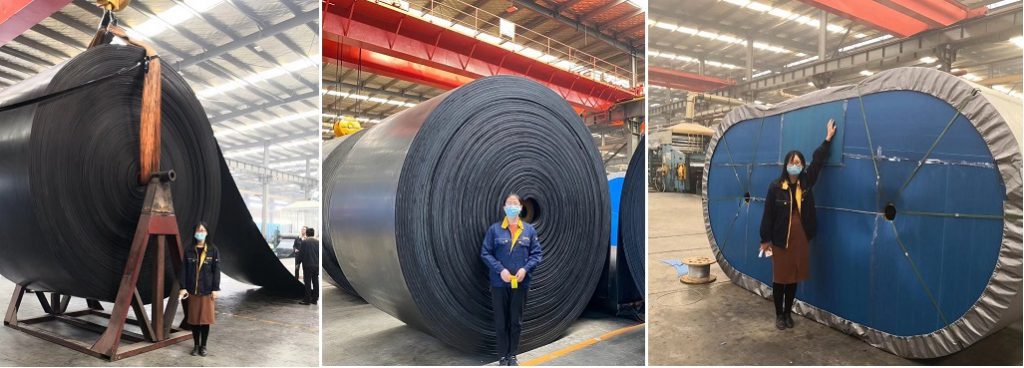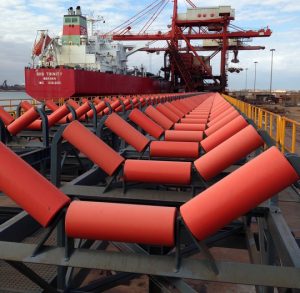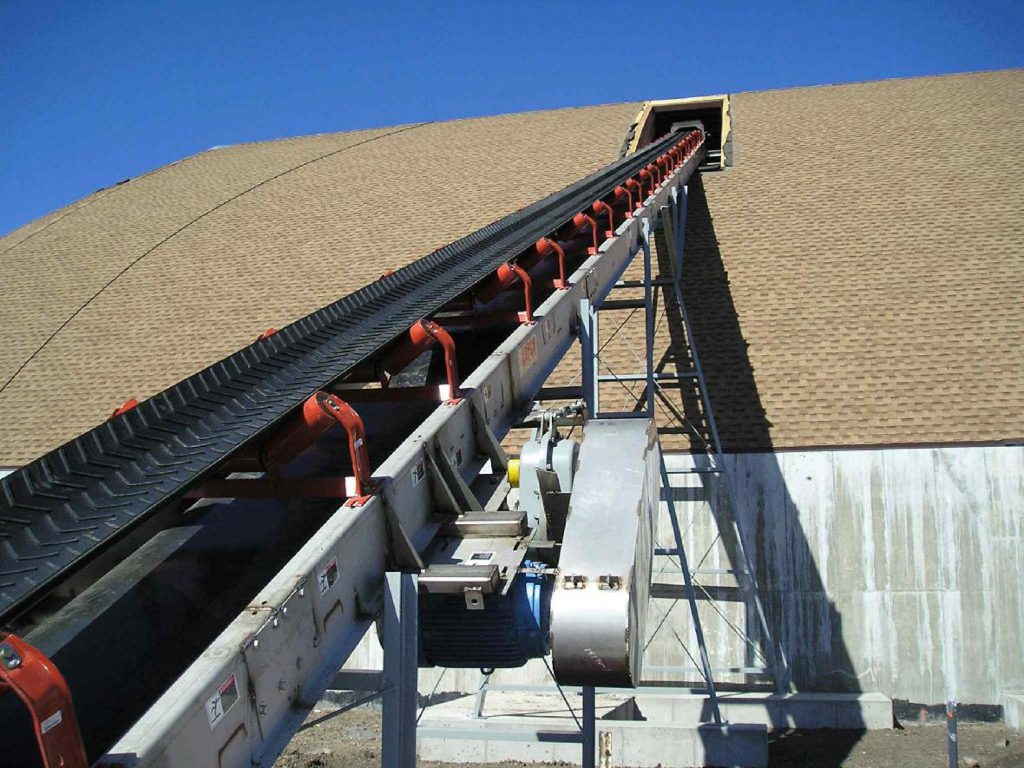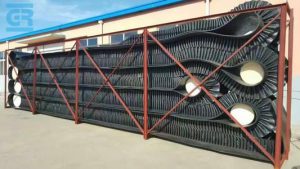How to increase the conveyor inclination angle


The belt conveyor is driven by an electric roller, which drives the conveyor belt to run, thereby conveying materials. The belt conveyor has the advantages of large conveying capacity, low running resistance, low energy consumption, stable operation, small material breakage during transportation, continuous operation, and easy automatic control. It is also an indispensable equipment in the process of bulk material transportation. Belt conveyors can run along horizontal lines or diagonal lines. Usually smooth conveyor belts are used. The friction generated by the weight of the conveyed material runs through the conveyor belt with animal materials, thereby limiting the working inclination. Generally speaking, the upward angle does not exceed 17-18 degrees, and the downward angle is smaller. In order to be able to be used at a larger angle of inclination, we make some suggestions as follows.
1. Increase the trough depth of the conveyor belt.
The trough idler of ordinary belt conveyor is mainly composed of three equal-length idlers. The angle of inclination of the two side rollers is called the trough angle and is usually 35°.
(1) Increase the angle of the supporting rollers on both sides of the bracket from 35° to 60°, and then reduce the length of the intermediate supporting rollers to form a deep trough carrying section, which can improve the transportation inclination of bulk materials.

(2)Multiple rollers are used to increase the trough depth: this structure uses a trough roller group consisting of five single-row rollers. As the trough depth of the conveyor belt becomes larger, the conveying inclination angle also increases accordingly. However, due to this The middle idler roller of the idler group is flat, so the friction between the material and the conveyor belt is very small, especially when the load is small, the friction is even smaller, so the maximum conveying inclination angle is limited to 22°. Because of the idler roller The idler rollers of the group are short and non-standard idler rollers, which have high manufacturing cost and poor interchangeability. In order to solve the above problems and further improve the conveying inclination, a double-row “V” deep trough idler roller group is adopted. It has the following characteristics: the bottom idler is a double-row V-shaped, the maximum conveying inclination angle can be increased to 28° for upward conveying and 25° for downward conveying; after the double-row staggered arrangement of the supporting roller group, the sharp angle of the supporting roller end No contact with the conveyor belt, reducing the wear of the conveyor belt and prolonging the service life; the roller group adopts 4 standard rollers, which is 1 less than the original deep trough roller group, which not only saves labor and materials, but also facilitates production and maintain.
2. Increase the friction between the conveyor belt and the material.
Conveyor belts are the carrying and traction components of belt conveyors. The materials on the conveyor belt run together with the conveyor belt. The conveyor belt must not only have the carrying capacity, but also have sufficient strength. The use of a “Patterned” or “Chevron” conveyor belt can increase the inclination. If the raised edge on the surface of the conveyor belt is too high, it is difficult to clean the conveyor belt. Changing the pattern or chevron parameters on the conveyor belt surface can improve the inclination angle used. However, the wear of the pattern will affect its carrying effect.

3. Add an auxiliary conveyor belt to compact the belt conveyor.
Also known as pinch belt conveyor, in order to add an auxiliary conveyor belt to the supporting part of the conveyor belt. The auxiliary conveyor belt is actually a powered endless continuous conveyor belt. It runs synchronously with the material. With the aid of the weight of the auxiliary belt and the pressure applied to its surface, the loaded material is pressed against the conveyor belt to prevent it from sliding down and being discharged to the upper opening, thereby achieving the purpose of increasing the conveying inclination. There are many pressure methods on the back of the working section of the auxiliary conveyor belt. One is to place the roller group on the auxiliary conveyor belt at a certain distance. The trough shape of the idler group is different. Each roller group is pressed tightly on the auxiliary conveyor belt by spring force, air pressure or hydraulic pressure. The requirements for the pressurization device are: there is enough pressure to prevent the material from slipping. Pressure is everywhere; pressure should be elastic.
4. Select sidewall conveyor belt:

The main difference between sidewall belt conveyor and ordinary belt conveyor is the conveyor belt and supporting roller. It mainly consists of baseband, sidewall and diaphragm. The sidewall and baseband were vulcanizated together. The outer side of the sidewall is provided with reinforcing ribs, so that the sidewall has greater support strength and longitudinal and lateral stability. The upper part of the sidewall has good flexibility, so the conveyor belt can be easily stretched and compressed when bent. The partition is divided into two types: detachable and fixed. The detachable diaphragm is mechanically fixed on the base band. The fixed diaphragm is T-type and C-type TC, and is bonded to the base tape by cold glue. When the inclination angle is less than 40°, the T-shaped diaphragm is generally used for transportation, and the inclination angle can be selected from TC or C type. Due to the special structure of the sidewall conveyor belt, special requirements are also placed on the structure of the idler. The upper branch of the conveyor belt can use standard parallel rollers. The lower branch rollers generally use composite rollers or rollers to support the edge of the baseband outside the sidewall; parallel rollers can also be used to support the top of the sidewall, but the top of the sidewall is seriously worn. The special structure of the sidewall conveyor has formed its use characteristics: it can increase the transportation inclination of the conveyor to about 80°. The construction area of the equipment can be saved. Due to the existence of the sidewall, the conveying capacity can be greatly improved; because of the increased rigidity of the conveyor belt, the possibility of deviation of the conveyor belt is very small.





Tags: conveyor belt incline angle,pattern conveyor belt,sidewall conveyor belt





